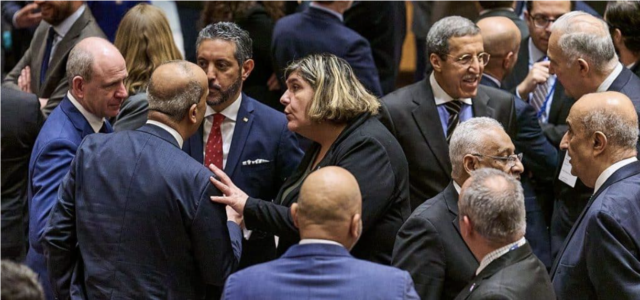Security Council Reform: When and How It Can Be Done (安全保障理事会改革: いつ、どのようにできるか )
Opinion by Sukehiro Hasegawa, Kerstin Leitner , and Georgios Kostakos Jan.14, 2025
2025年に迎えるにあたって、世界は混乱、紛争、苦難に見舞われ、国連は弱体化し、人道支援以上の成果をあげることが出来ないでいる。しかし、安全保障理事会が国連憲章に規定されたとおりに機能すれば、世界は持続可能な平和と繁栄を達成する可能性が高まるであろう。
世界の指導者たちは、2024年9月22日に開催された「未来サミット」で「未来協定」を採択した。各国首脳は、安全保障理事会をより代表的、包括的、透明、効率的、効果的、民主的かつ説明責任のあるものに改革し(行動39)、総会との関係を強化し(行動41)、政府間交渉(IGN)の枠組みで優先的に、かつ遅滞なく取り組む(行動40)ことを確認した。
安保理改革に関する交渉が実質的な成果を達成するのを支援するため、私たちは政府間交渉(IGN)が焦点を当てた5つの重要課題を土台とする、安全保障理事会改革への2段階アプローチを提案する。それらは、拡大された安全保障理事会の規模、理事議席のカテゴリー、地域代表、拒否権関連の問題、そして安全保障理事会と総会の関係である。
最初のステップは、国連創設80周年を迎える2025年9月の総会で、安全保障理事会の拡大と新たな理事国の議席のカテゴリーと配分について決定することである。このプロセスは数年以内、あるいは2030年の国連創設85周年までに憲章改定へと結実するはずである。第二段階では、国連憲章第109条に基づく国連加盟国の全体会議を開催し、遅くとも国連創設100周年の2045年末までに、理事会および国連全体のより包括的な改革を行うことである。
国連において不可欠なプレーヤーとして認知されたいというアフリカ諸国の願望を実現するため、アフリカ諸国に安保理常任理事国の議席を新たに2つ与えるという提案がなされている。これは理性的というよりは、政治的かつ感情的な要求であり、ドイツと日本、そしてブラジルとインドの「G4」諸国が長年にわたって常任理事国入りを主張してきたのと同様である。しかし、このようなアプローチは、理事会の寡占的な性質を強めることになる。世界全体の平和と安全を維持することを目的とする組織である以上、理事国は自国や地域の代表であるべきではない。また、国連加盟国全体、そして平和が公共財であり、持続可能な開発目標などを達成するための基盤である世界の人々に対して説明責任を果たすべきである。
国連安保理改革をこれ以上遅らせないために、私たちは最初のステップとしては、さまざまなグループから提案された理事会拡大モデルを決議案として総会に提出し、投票でもって決断することを提案する。そして、どのモデルも採択されなかった場合、IGNは加盟国からなる草案作成グループを立ち上げ、総会での採択に向けたモデルを作成すべきである。このようなモデルでは、理事会の理事国を5年更新制で10議席増やすことである。これらの新た10議席はアラブ連盟も地域とするとした地域に配分して、小島嶼国連合(AOSIS)や内陸開発途上国(LLDCs)のような加盟国の主要な「機能的」または「利益」グループの代表も確保できるようにすることである。また、新たな10議席の選出基準として、国際の平和と安全、および国連の他の活動への貢献、国連加盟国全体の少なくとも3分の2からの信頼と信任を得ることなどが挙げられる。
私たちの理事会改革案の第2段階として、常任理事国5議席を、地域要件も拒否権もなく、再選には上記と同じ基準が適用され、10年更新の任期制議席に変更することである。その上に加盟国の国民を代表する議会が新設され、各国の実績について総会に助言することができることとする。この10年更新の任期制5議席には、アフリカ連合、欧州連合、東南アジア諸国連合、アラブ連盟などの地域組織も候補となりうることとする。
このような2段階の改革を経て、国連は25カ国の理事国からなる理事会で第2世紀をスタートさせることができる。理事国はいずれも常任理事国ではなくなり、拒否権を行使することもできないが、その代わりに選挙で選ばれることになる。
私たちは、IGNによるこれまでの大きな進展を評価するとともに、ウェストファリア的な考え方の枠を超え、世界中の国連国民を代表し、効果的で、説明責任を果たす、より正統的な安全保障理事会に向けた第一歩を踏み出すよう呼びかける。







長谷川祐弘氏以下3名の元国連シニアスタッフの安保理改革提案へのコメント
神余隆博 関西学院大学学長特別顧問(元国連大使:次席常駐代表)
元国連シニアスタッフの3人による国連安保理改革提案は、国連創設80周年から85周年を第一段階、100周年までを第二段階とする2段階の改革案を示しています。
第一段階では、2030年までに安保理の新たな議席拡大ならびにその種類と地域等への配分を決定し、再選可能な5年任期の理事国を10カ国創設することが提案されています。この案は、安保理の特権的性格(oligopolistic nature )のさらなる拡大を防ごうとするもので、多くの加盟国やその国民の期待に応える内容となっています。一方で、新議席の対象を地域組織(アラブ連盟: League of Arab States等)や小島嶼連盟(Association of Small Island States: AOISIS)などの利害関係組織にも拡大するという提案については、これらの組織の意思決定の迅速性や実効性に課題があり、現実的な運用に疑問が残ると思います。特に、意思決定が迅速に行われない場合、地域組織等が安保理での責任を十分に果たせないことが懸念されます。
第二段階では、5常任理事国を10年任期で再選可能な長期の理事国に転換するという大胆な提案が行われています。しかし、この改革案には現実的な障壁が多く、既存の常任理事国による強い反発や、国連憲章改正案批准時の拒否権行使が予想されます。特に、この長期の理事国の対象をEU、AU、ASEANなどの地域組織にも拡大することについては、第一段階と同様の問題があり、より深刻な影響を与える可能性が指摘されます。
この提案は、第二段階だけではなく、第一段階の改革も国連憲章の改正を必要とすることに言及していません。憲章の改正は加盟国の3分の2による賛成と憲章改正案の批准が必要で、この批准の段階で常任理事国は拒否権行使が可能です。第一段階の改革も常任理事国の拒否権で改革案が葬られてしまうリスクは常に存在しているため、常任理事国が賛成できる案を慎重に交渉しなければなりません。第二段階の改革が明らかに彼らにとって不利になることが予め明白な改革案は、第一段階の憲章改正案の決議採択と批准の際に潜んでいる潜在的な危険性です。そのような観点からは。第二段階での改革案に現時点では具体的に踏み込まず、常任理事国の構成、拒否権等に関して検討を行うことを簡単に触れるのみにとどめておいた方が交渉戦術の観点からは良いのではないかと考えられます。
他方で、提案には「Parliamentary Assembly」を設置し、長期の理事国のパフォーマンスを監視するという斬新なアイデアも含まれています。この仕組みは、現行の常任理事国に対しても適用し、その行動を評価・報告することで常任理事国の専横的行動を抑止する効果が期待されます。権限・構成・選出方法等議論を呼ぶ要素は多いものの、アイデアとしては興味深く、国連総会決議等での導入は検討に値するものと思われます。
一方で、提案全体には課題も多く、特に第二段階の改革案は、常任性と拒否権という特権を奪われる既存の常任理事国の強い反発を招くため、現実的な実現可能性は低いと考えられます。これにより、場合によっては常任理事国の一部およびそれに同調する国が国連を脱退するリスクすらあり、過去の国際連盟の衰退と同様の道をたどる可能性も指摘されます。
提案は安保理改革に関する興味深い要素を含む一方で、実現可能性を考えると現実主義(リアリズム)と交渉力学に基づいた漸進的な改革を目指す必要があります。今日の国際情勢は大国間の対立や分断、ポピュリズムやナショナリズムの台頭など、第二次世界大戦前と同様の不安定な要素が多く、安保理改革が国際秩序の不安定化や新たな紛争の引き金とならないよう慎重に進めるべきです。理想論ではなく現実主義に基づき、大国の国連脱退リスクを防ぎつつ、安保理改革を実現可能な形で進めることが求められています。
今回の提案は、世界政治の現実に即して実現可能な部分を採用し、実現困難なアイデアについては再検討を行う必要があります。3人の提案者の意図がそうでないことは勿論分かっていますが、改革の目的は国連を分断させるのではなく、現状を漸進的に改善し、より良い方向に向かわせることです。このため、国際情勢や地政学的な影響を慎重に考慮した実現可能かつ持続可能な改革案が求められます。
Comments on the UN Security Council Reform Proposal by Dr. Sukehiro Hasegawa and Two Other Former Senior UN Officials
By Dr. Takahiro Shinyo, Professor and Special Advisor to the President of Kwansei Gakuin University (Former Japanese Ambassador and DPR to the UN)
The UN Security Council reform proposal by three former senior UN officials outlines a two-stage reform plan, with the 80th to 85th anniversaries of the UN as the first stage and by the 100th anniversary as the second stage.
In the first stage, the proposal suggests that by 2030, the Security Council should decide on the expansion of its membership, including new categories and their distribution, and establish ten new member states serving as council members with a renewable five-year term. This proposal aims to prevent further expansion of the Council’s oligopolistic nature, addressing the expectations of many member states and their citizens.
However, the suggestion to extend new memberships to regional organizations such as the League of Arab States or common- interest- based organization such as the Association of Small Island States (AOSIS) raises questions about the efficiency and effectiveness of their decision-making processes. Concerns remain about the operational viability of such memberships, especially if these organizations fail to make timely decisions, potentially hindering their ability to fulfill responsibilities in emergency cases within the Security Council.
The second stage includes a bold proposal to convert the five permanent members into long-term members with renewable ten-year terms. However, this reform presumably faces significant practical obstacles, including strong opposition from current permanent members and the anticipated use of veto powers during the UN Charter amendment process, particularly at the ratification timing. The idea of extending long-term membership to regional organizations such as the EU, AU, and ASEAN encounters similar issues as in the first stage, but with potentially greater impact and complexity.
This proposal also fails to mention that not only the second stage of reform but also the first stage requires amendments to the UN Charter. Amending the Charter requires the approval of two-thirds of the member states and ratification of the amendment proposal. At the ratification stage, the permanent members of the Security Council can exercise their veto power. There is always a risk that the reform proposal for the first stage could be nullified by a veto from a permanent member. Therefore, it is essential to carefully negotiate a proposal that the permanent members can agree on.
Proposals that are clearly disadvantageous to them in the second stage of reform pose a latent risk during the resolution and ratification process of the Charter amendment proposal in the first stage. From this perspective, it might be more prudent, from a negotiation strategy standpoint, not to delve too deeply into specific proposals for the second stage of reform. Instead, it would be better to limit the discussion to a brief mention of considering the composition of the permanent members, veto power, and other related issues.
Additionally, the proposal includes a novel idea to establish a “Parliamentary Assembly” to monitor the performance of long-term members. This mechanism would also apply to the current permanent members, evaluating and reporting their actions to deter unilateral behavior. While the concept is intriguing, debates are likely regarding its authority, composition, and selection methods. Nevertheless, the idea merits consideration through a UN General Assembly resolution.
On the other hand, the proposal presents serious challenges, particularly the second stage of reform. Depriving current permanent members of their privileges of permanency and veto power would likely provoke strong resistance, making its realization highly unlikely. This could even lead to the eventual withdrawal of some permanent members and their allies from the UN, raising the risk of the UN facing a decline similar to that of the League of Nations.
While the proposal contains compelling elements for Security Council reform, a pragmatic and gradual approach grounded in realism and the dynamics of diplomatic negotiation is essential. Given the current international environment, marked by great power rivalry, division, and the rise of populism and nationalism—reminiscent of the pre-World War II era—it is vital to avoid reforms that could destabilize the international order or trigger new conflicts. Reform efforts should focus on achievable measures that prevent the withdrawal of major powers while ensuring realistic progress.
This proposal requires careful selection of actionable ideas while reevaluating impractical ones. Although the intent of the three proponents is undoubtedly to improve the UN, the objective of reform should be to gradually enhance the current system rather than divide the organization. A sustainable and achievable reform plan, informed by geopolitical realities and international circumstances, is imperative.